The MyHeritage Photo Enhancer can make blurry family photographs from the early 1900s look like they were taken with a high-resolution camera. The results can be remarkably good.
The application also tries to replace blurred or obscured parts of your images using complex algorithms. This article looks at how this works (and sometimes doesn’t work). The second half of the article has our best tips on using the MyHeritage Photo Enhancer.
How Does The MyHeritage Photo Enhancer Work?
The most obvious feature of the MyHeritage Photo Enhancer is that it increases the clarity and sharpness of old photographs.
In addition, the application uses advanced techniques to edit parts of your images that are blurred or obscured. This used to require laborious “touching up” with expensive software. MyHeritage puts automated options into your hands.
Removing scratches and creases
The Enhancer will also reduce or remove scratches and creases, particularly from faces in the photograph.
The application works mostly on faces. You can end up with a clear and unblemished face, while the clothing and background remain slightly blurred and creased.
If you’ve used Photoshop or similar image applications, you’ll know that they have features that can “descratch” photos and apply smoothing effects.
However, the MyHeritage Photo Enhancer goes one step further. It can add elements that weren’t in the original photo. This can be a little controversial, so let’s look at this aspect in more detail.
Machine learning can alter the image
If facial parts are blurred or obscured, a more complex process comes into play. The Enhancer will attempt to infer (or guess) what “should” be in this piece of the image.
It makes decisions through comparing and learning from a big database of photographs. The Enhancer will replace or redraw small obscured elements in the original image by using photographs it considers to be very similar.
To take a practical example, suppose one eye is obscured or shaded in a headshot. The application will attempt to use the other eye in the photograph as a reference for size and shape. It can then replace pixels with what it has learned within the same photograph.
The Enhancer isn’t always right but is getting better
But what if both eyes are obscured? Or what if the upper lip is obscured by a dark shadow?
The Enhancer reaches out to its knowledge base of photographs to make a best guess for replacement. Aspects such as ethnicity and time period will be used to collect the best options for similar photographs.
Early users of the application noted that eyes tended to be too round in shape in restored photos of people that they knew. The great benefit of using a web application is that the database behind it will grow and the machine learning elements can improve.
I see few complaints this year about eye shape. I assume that the algorithm has been tweaked to ensure more variety of facial features.
Adding fake parts to a photograph
However, other complaints are made about the Enhancer adding glasses and mustaches where they never existed.
I refer to this as the Groucho Marx effect later on in this article, where I’ll show you an example from a photo I uploaded in 2021.
Is The MyHeritage Photo Enhancer Free?
There is a limit to the number of photos you can enhance through a free MyHeritage account. That limit has changed over time. In fact, it has reduced from about ten photos down to a lower number.
Even when you’re within your limit, the images enhanced through MyHeritage are watermarked with the free account.
Of course, there are ways to bump up your number of free photos. You only need a valid email for a free account on MyHeritage, you don’t need to input credit card details. If you end up on a page that looks for payment details, you can exit out out it and your account is still created.
You also have the option of using the Enhancer application outside of MyHeritage. The free mobile app doesn’t have watermarked images, but you may find yourself driven mad by the adverts. I have more details in a later section on the Remini mobile application.
Unlimited photos
Currently, you need a subscription to have unlimited photo enhancements and unwatermarked images.
How To Use The MyHerirage Photo Enhancer
You need at least a free account with MyHeritage in order to use the Photo Enhancer. When you are logged into your MyHeritage account, the enhancer is available from the Photos menu on the MyHeritage website.
- Expand the Photos drop-down menu and choose the “Enhance photos” option.
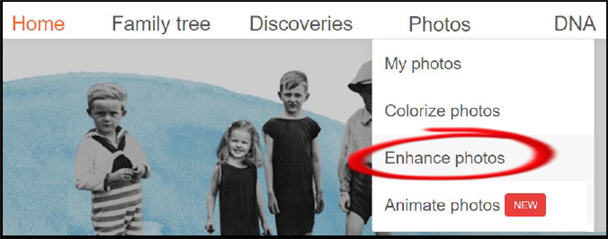
- The Upload button opens a file explorer on your local machine to choose one photo at a time.
- Once your photo is uploaded, the enhancer will take a few seconds to complete.
The amount of time for processing depends in part on the number of people in the photograph. The processing time won’t take more than a minute.
- Examine the before-and-after shots of your uploaded photo with the slider.
The slider moves left and right to show what the enhanced image looks like in comparison to the original upload. If you don’t see increased clarity with a photo from the early 1900s, the image you have may already have been enhanced using other means.
The second half of this article has a selection of tips on getting the best out of the Enhancer. It will also explain some problems you may encounter with the enhanced images.
- Review the isolated parts of group photos underneath the main image.
The Photo Enhancer attempts to isolate individual faces within group photographs. Individual images are prepared for each isolated part. They are shown in a carousel beneath the main image.

This is a very powerful feature and is usually successful with faces in the foreground or near-foreground of the image. See our photo enhancer tips for examples of when it works (and doesn’t).
What Program Does MyHeritage Use To Enhance Photos?
MyHeritage didn’t develop the Enhancer application in-house. Instead, they licensed the technology from another Tel Aviv-based company: Remini.
Remini was founded in 2013 as a software company specializing in online applications for the child care and education market.
Both co-founders studied Information Systems at Ben Gurion University. Raz Wasserstein further specialized within information privacy, while Dorn Oded’s thesis was on machine learning.
Their original application focused on image-capturing for children’s developmental milestones.
Remini went on to create a mobile phone app for photo enhancement. MyHeritage has licensed this technology for use on its own servers.
Using The Enhancer Technology Through The Remini Phone App
The Remini mobile app (available via Google Play Store) is also available as a separate mobile installation. It has a free tier that allows you to enhance five photos per day. Unlike within MyHeritage, you get another five uploads as each day rolls over.
The drawback with the free tier is that it includes advertising. This may not bother you at all. Just be warned that there are a lot of adverts during normal usage of the app!
If five photos per day aren’t enough for you, there is also a monthly subscription and options to purchase credits.
Tip #1: Try The Enhancer With Blurred Faces In Group Shots
The Enhancer doesn’t play very well with people in the far background. And it can mess up group shots when it sometimes blurs features from one individual into another.
However, don’t miss out on getting fantastic results with front-facing heads in the middle rows of group shots. These may be the only images you have of a relative, and you could find the Enhancer gives you a gem.
Let’s look at an example. This is a photograph from 1921 of the burial of Irish leader Michael Collins who was shot in an ambush during the Irish Civil War.
A gravedigger is out front and out of focus, while a line of officers salutes their fallen commander. But I’ve highlighted a face in the row behind.
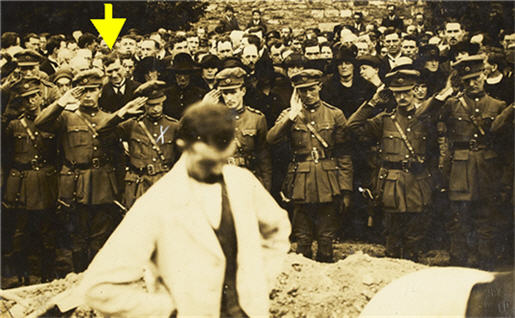
Imagine that’s your ancestor. You might skip this photo because he’s in the background.
But it’s worth trying these types of photos and allowing the MyHeritage Photo Enhancer to pick out the individuals. The website page will offer you the different faces that it attempts to enhance.
Here’s the Before and After they offer me.
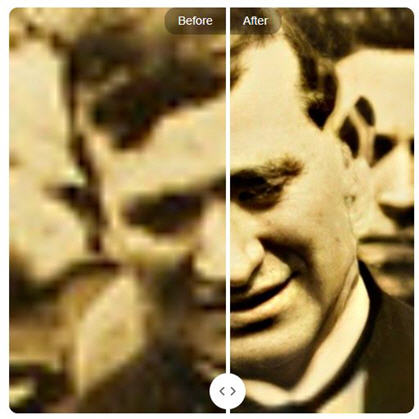
Yes, there’s a problem with the ear of the “After” profile. The Enhancer is having problems distinguishing the edge with the person behind this man. But the clarity is remarkable.
If this was the only photo you had that contained a particular ancestor, it was well worth seeing how the Enhancer dealt with it.
Tip #2: Try It With Old Newspaper Images
Here’s a grainy old image from an Irish newspaper in 1971. The gentleman was government minister Gerry Collins, and he’s meeting with a group of women in front (I think) of government buildings.
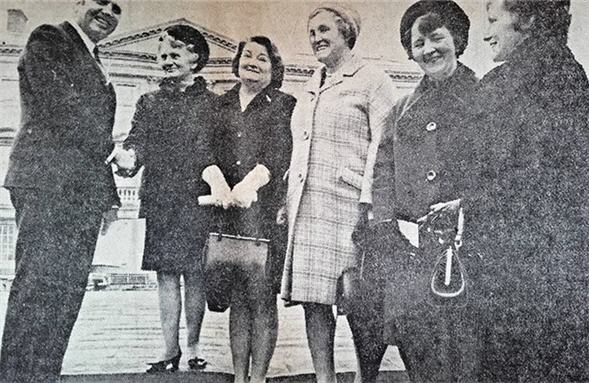
It’s not great quality, is it? But suppose one of these fine ladies was your great-grandmother. What can the Photo Enhancer do?
Well, it depends on which one you’re looking for. I’ve highlighted what I consider to be the worst of the effects. But I think the enhancement to the other faces is pretty good. I’d be quite happy with any of the other four ladies.
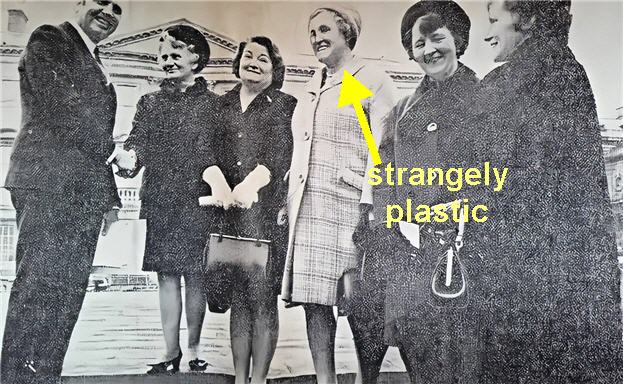
This is what I mean by “trying” the application – don’t give up if the first photo you upload looks plastic or strange.
You’ll also notice that the MyHeritage Photo Enhancer should be called the Face Enhancer. It doesn’t bother with clothing or landscape.
Tip #3: Rinse And Repeat (Once)
There’s nothing stopping you from putting the enhanced photo through repeat enhancement (well, except your membership level and we’ve got a tip on that too).
Don’t bother clicking around the MyHeritage interface looking for a repeat button. You’ll need to download your enhanced photo and reupload it.
I find that running it a second time may produce a slightly sharper result. However, further repeats end up distorting the image. Your experience may vary.
Tip #4: Avoid Far Faces
The MyHeritage Photo Enhancer does weird things with faces that are far into the background.
Take a look at this photograph, again of Irish leader Michael Collins. I’ve highlighted a sitting figure far off in the background. Can the MyHeritage Photo Enhancer work its magic with that guy?
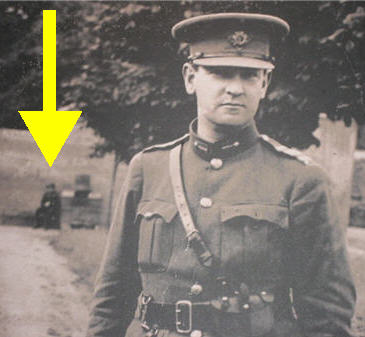
Umm, no. I get this weird attempt at a face that is somewhat akin to Munch’s The Scream.
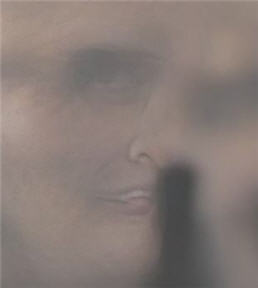
I think the dark section was the sitting man in the original image. The Photo Enhancer has plopped a misshapen eye, nose, and mouth into a “headshot” which I will not be hanging on my wall.
This should help you understand why you’ll see some references to creepy results when people are commenting on enhancements “gone wrong”.
Tip #5: The Groucho Marx Effect – Be Wary Of Fake Moustaches And Glasses
A picture tells a thousand words, so let’s look at an example.
Here is a group photo with Michael Collins in 1921. The Dublin hurling team has just won a big match (hurling is an Irish sport akin to lacrosse). Collins is on the left, shaking hands with sports administrator James Nowlan.
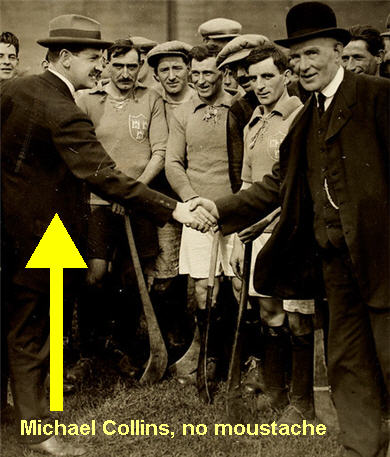
Here’s the before and after, left and right. The close-up has Collins with the Dublin captain, Bob Mockler. There are more hurlers behind the two men. Unfortunately, the “enhanced” image on the right is a right mess.

It’s not just the weird elements between the two heads, where the Enhancer seems to be adding an extra ear.
Notice that Collins has been given a mustache! The original image simply has a shadow above his lip.
The Photo Enhancer has faked a rather prickly mustache here. I wonder if it’s inferring what it should look like from Mockler’s genuine article?
I’ve seen other people report that mustaches magically appear when a hand is touching a face. One lady was very annoyed that her grandmother had been given a beard (in place of a scarf).
I’ve also seen reports that eyeglasses are sometimes added when only a partial face is available.
Photography expert Unmesh Dinda noted that the application had recognized earrings on his relative. But as they were blurred, it “replaced” them with a much sharper set of earrings that were quite different to the original.
I wonder if that’s what’s going on with the weird spots where Mockler’s ear should be. Has MyHeritage given him a few punk studs?
You’ve got to look very carefully at the original to make sure that the MyHeritage Photo Enhancer isn’t adding fake elements.
Tip #6: How To Add Enhanced Photos To Your MyHeritage Tree
MyHeritage didn’t develop the Photo Enhancer in-house, they’ve licensed it from an independent software company.
Maybe that’s why the feature isn’t fully integrated with the rest of the MyHeritage website. At the time of writing, there is no link within the Photo page to shoot it over to a person in one of your family trees. I’ve put this tip here to save you the time of looking for it.
Instead, you’ll need to download the enhanced image to your local machine.
Then you can open the profile of the person in your MyHeritage tree. Go through the usual steps of uploading the image to the person’s card.
Tip #7: How To Stop People From Taking Your Enhanced Photos
I saw an upset comment on Facebook from a MyHeritage customer who had created an enhanced photo of a relative. She spotted the photo attached to someone else’s tree and was wondering how anyone else could take images from her online photo album.
The problem here is that many MyHeritage users don’t realize that there are separate privacy settings for different aspects of the website. I don’t blame anyone for missing particular settings, it’s not laid out in a helpful manner.
Follow these steps to make your photo albums private (they are public by default).
- Expand the menu under your account name and click on the “My privacy” menu item.
- Choose the “Content” link at the bottom of the left sidebar.
- The Photos privacy section is at the bottom of the content page.
- Uncheck one or more albums that you wish to privatize.
Note: all photographs are reproductions from public collections.